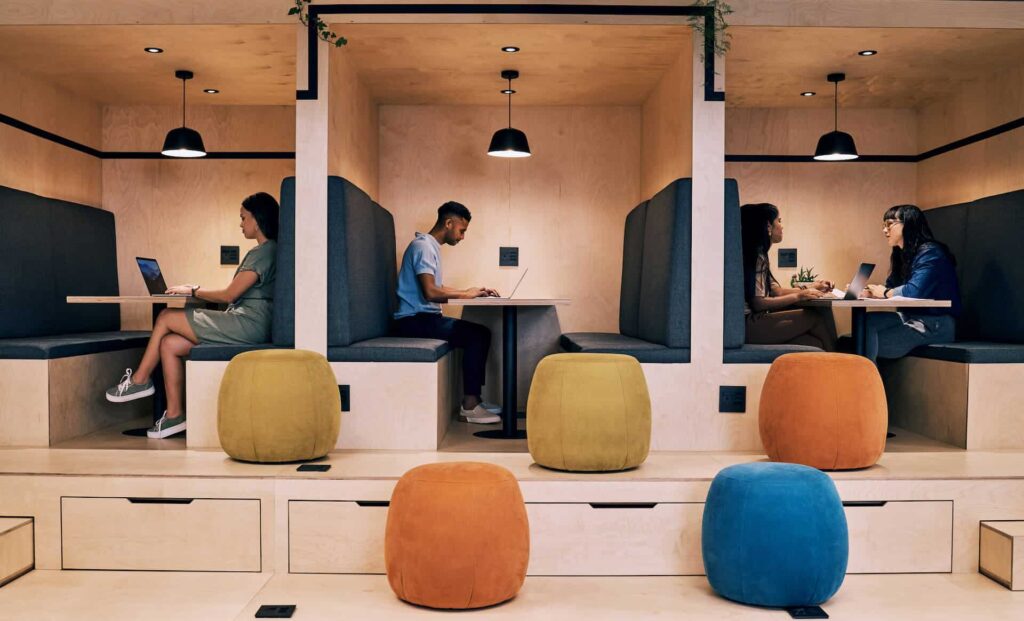Workplace wellbeing: Tips to improve wellbeing at work in 6 key areas

Workplace wellbeing is linked to so many of today’s biggest buzzwords. For example: employee engagement, job satisfaction, work-life balance, and company culture, just to name a few.
But wellbeing in the workplace is about a lot more than paying lip service to buzzwords. It’s about recognizing that employee wellbeing is the best foundation for longevity and growth. Ensuring your people are well supported is the right thing to do, but it’s also a smart business move.
Employee wellbeing encompasses much more than physical health, stretching into mental health, emotional wellbeing, and more.
And of course, like practically everything surrounding the return to the office, the ability to foster employee wellness now has even more complications because of hybrid work.
In this article, we explore workplace wellbeing in six critical areas, including key tips that business leaders can follow to promote more wellbeing at work.
What is wellbeing in the workplace?
Wellbeing in the workplace is the big picture of an employee’s whole working life.
It’s about the impact that workplace experience, workplace culture, and other key elements have on the overall health and wellness of employees, along with their sense of purpose ‘on the job.’
Workplace wellness isn’t just about the physical health of employees. Although this is certainly a critical aspect, as we’ll explore below.
It’s about looking at all aspects of workplace life holistically, including the emotional, mental, social, and financial health of employees.
When companies address all areas of workplace health with good wellbeing initiatives, employees are happier, more productive, and more likely to stick around for the long term (essential now as we’re grappling with the long term effects of the Great Resignation).
The vast majority of organizations now understand the importance of employee mental health and wellbeing. But there’s often an implementation gap.
And thanks to the rise in hybrid and remote working, addressing employee wellbeing across a distributed workforce can be even more challenging.
That’s why any company looking to both retain employees and attract top talent needs to invest in meaningful wellness programs and policies. It’s also smart to develop a more flexible work culture. This can support and help employees in all aspects of work, wherever they do it.
There is a strong business case for promoting the wellbeing of workers.
Christian Krekel, George Ward, and Jan-Emmanuel De Neve, Saïd Business School, University of Oxford
What are the benefits of wellbeing in the workplace?
It’s a simple truth: everyone wants to work for a company that treats them well.
Another simple truth: good wellbeing programs and health promotion can lead to happier and healthier employees.
This, in turn, can lead to more empowerment in the workplace, less absenteeism (and its ugly and equally as unproductive twin, presenteeism), fewer sick days, and generally a nicer office.
And from a more cynical perspective, promoting health and wellness is simply good for the bottom line. Workplace wellbeing is good for staff retention and attraction, and it’s also linked to increased productivity, too.
In fact, according to research from Oxford’s Saïd Business School, companies with high levels of employee wellbeing enjoy higher productivity. And even higher stock market returns.
Specifically, researchers found “a strong, positive relationship between employee wellbeing, employee productivity, and firm performance.”
What is the key to wellbeing in the workplace?
The key to wellbeing in the workplace is making it a priority, and being proactive about it.
Wellbeing in the workplace isn’t just about stocking the pantry with some healthy snacks and calling it a day.
It’s about looking at the current and future needs of employees (and soliciting their feedback). And then creating a working environment and structure that will meet those needs.
Of course this includes wellness initiatives (hopefully moving beyond physical health perks alone).
It should also include providing employees with the right training, working conditions, and physical and digital workspaces that allow them to do their best—and healthiest—work.
Ultimately, companies need to preemptively address all aspects of employee wellness if they truly want happier and healthier people.
Leaders now view wellbeing not just as an employee benefit but as an opportunity to support employees in all aspects of their personal and work lives.
Jeanne Meister, Forbes

How can you improve wellbeing in the workplace?
Improving wellbeing in the workplace starts at the top, with good leadership and a commitment to wellness.
Gallup research finds that employees who feel informed by their managers are also four times more likely to feel like their company cares about their wellbeing.
One of the lessons we learned from the pandemic is feeling like you’re in the dark is incredibly stressful. The onus is therefore on companies to ensure that they’re clearly communicating with employees, possibly with more involvement from HR.
It’s also a good idea to survey workers about what their needs actually are. this makes communication more of a two-way street.
Moreover, employees need empathetic managers who keep them informed and make their wellness a priority. Managing remote and hybrid workers can be challenging. So companies should make sure managers get on-going training to ensure they’re rising to the challenge.
“There are best practices and nuances to managing a mixed remote and hybrid team. And there are benefits to having regular training programs,” says workplace strategist Angie Earlywine, Senior Director in the Total Workplace division of Global Occupier Services at Cushman & Wakefield.
Beyond good leadership, the road to creating more wellbeing will look different from company to company. And maybe even from department to department.
That said, companies will need to create policies, benefits, and perks to help employees in these six key areas. Note that many of these areas are overlapping. For example, setting up a sports league or getting involved in a community fundraising walk ticks just about every box below. When it comes to wellness, it’s never ‘all or nothing’ or ‘one and done’. Instead, think about how to create an overall environment that helps everyone thrive in the following areas.
1. Physical wellbeing at work
By now, we’re all aware that diet, exercise, sleep, and our lifestyle choices impact our physical health.
When applied to the workplace, there are many ways companies can help their employees stay physically healthy. This is assuming they are also providing first-rate extended healthcare benefits. For example, companies can:
- Invest in standing (or sit/stand) desks and/or more ergonomic workstations
- Offer a gym membership, onsite yoga, or other fitness classes (or a health spending account for other activities)
- Provide healthy snacks and lunches for in-office employees
- Encourage active community commuting (by installing secure bike racks, for example, or subsidizing public transportation)
Stress reduction is also essential for long term physical health, as much as for our emotional and mental health. A big way companies can help reduce stress for their employees is to ensure they aren’t working more than their fair share of hours.
For example, employees shouldn’t be expected to regularly work overtime, and they also shouldn’t be expected to be available 24-7. In other words, just because you’ve got a company phone and email, doesn’t mean your manager should expect you to be ‘on’ at midnight. Or up at the crack of dawn fielding calls.
This will help employees get the sleep they need, while also helping improve their mental and emotional wellbeing as well.

2. Mental and emotional wellbeing at work
In the 21st century, we’ve finally clued into the fact that mental and emotional health is just as important as physical health.
Employers, too, are learning that mental health issues need equal billing with physical health.
Consider the following (quite alarming) numbers:
- 42% of women in the workforce report experiencing burnout
- Gen Z workers report feeling emotionally distressed at twice and triple the levels of their older colleagues
- 60% of American workers have concerns about their mental health post-pandemic
- A major 2021 survey found that two-thirds of employees have symptoms of anxiety and depression
To improve this outlook, employers can include counseling and other paramedical services in their health care plans, along with an employee assistance program (EAP). Mental health days, and/or a generous sick day policy that allows for mental health issues, are also always welcome.
Companies should also take note of the extra stresses placed on parents and caregivers. Flexible hours and a more flexible work environment can really help here.
Beyond this, two of the best ways to support mental wellbeing at work are to provide more autonomy and flexibility.
The importance of autonomy and flexibility as it relates to workplace wellbeing
As much as possible, companies should trust people to make the best choices for themselves around how, when, and where they work.
We know that employee experience scores jump from 45% to 74% when employees have meaningful choice and flexibility. I.e.: when they’re able to choose not only where they work, but when).
And more and more research is showing that flexible work arrangements like four-day weeks have a host of both mental and physical health benefits.
Of course, many of the physical health ideas we’ve already covered (stress reduction, gym memberships, more physical activity, etc.) will also help with mental wellbeing.
And finally, never underestimate the feel-good power of ‘bring your pet to work’ day for boosting morale and mental health. Survey your team, and see what else might help them feel happy and connected at work.
3. Social wellbeing at work
Relationships matter—which includes our relationships with our co-workers.
Consider that having a workplace ‘best friend’ creates more engagement and higher work performance. This ultimately leads to fewer safety incidents, more engaged customers, and higher profits.
And despite all the many benefits of working remotely, the people who do want to come back to the office tend to cite collaboration and workplace relationships as the main reason.
In short, community building at work has always been important. And it’s equally important, if not more so, in a hybrid office environment.
Company-wide socialization events, team bonding over a meal or drinks, and fun games and activities together have always been smart. And yes—all these activities can be done over Zoom and Slack channels. This is assuming you have good (and well-trained) leaders willing to make the effort to keep everyone connected.
Finally, as we’ll explore further below, volunteering as a company can be great for socialization, and a lot more, too.
Our research has repeatedly shown a concrete link between having a best friend at work and the amount of effort employees expend in their job.
Annamarie Mann, Gallup
4. Community wellbeing at work
Employees don’t leave their community at the door; yes, they’re workers, but they’re also concerned citizens who often care deeply about their community.
“Offering employees opportunities to be involved in their local community will deepen the ties an employee has to their employer, their local community, and the planet,” says Jeanne Meister of Forbes, noting that time off for volunteering is quickly rising in popularity, with 47% of American companies now boasting community volunteer programs.
Note that these programs are as good for the workers and the community as they are for the company. Studies show they improve hiring, retention, and productivity.
People need a purpose larger than themselves. It fuels resilience and day-to-day motivation, especially during difficult times.
Jeremy Swanson, Jennifer Robison, and Sangeeta Agrawal, Gallup
5. Career wellbeing at work
Today’s employees expect you to invest in their professional development. As such, they should be given educational opportunities, regular performance reviews, and a clear career path.
For example, in the University of Phoenix’s Annual Career Optimism Index 2022, 68% of workers said they would permanently stay with an employer that was committed to upskilling them, while 29% don’t feel optimistic about the possibility of training or learning skills. Providing this upskilling therefore presents a great opportunity for companies to keep dedicated employees, who are committed to continually getting better at their jobs (talk about a win-win).
6. Financial wellbeing at work
Finally, concerns about your bank account can easily spill over into all areas of your life.
Financial wellbeing is closely linked to other areas of wellbeing. The 2022 PwC Employee Financial Wellness Survey shows that 56% of workers are stressed about their finances, impacting both their mental and physical health (along with their sleep, self-esteem, relationships, and productivity).
Moreover, only 42% of American workers reported having compensation that is not keeping up with cost of living increases.
This isn’t surprising, given the alarm bells for inflation and more instability that are constantly ringing.
But it is alarming—especially for companies looking to keep their employees. To combat this financial stress, companies may want to explore new or better retirement options, along with health spending accounts.

Using the physical workspace to help employees
One of the biggest (and most overlooked) factors that impacts workplace wellbeing is the workplace environment itself.
Thankfully, the days of uncomfortable and uninspiring cubicles are mostly behind us. Today, companies are adopting a variety of new and improved work environments types, creating a bespoke solution for their teams.
For example, activity-based working, agile working, and office neighborhoods can all get employees up and moving around the office, interacting with the space and each other in more uplifting ways.
Of course, these new workplace strategies require good desk booking and room booking options. Because getting frustrated while you try to find a seat is the opposite of wellness. They also require good meeting room design (and possibly digital meeting room signage). Wayfinding is also critical here.
Many companies are also now experimenting with flex room ideas that make the office a more fun, engaging place to be. Think game rooms to blow off steam, or retreat rooms to relax and refresh. They’re also making sure to include quiet booths and other areas of the office more geared towards heads-down work.
More and more companies are also investing in comfort for the office. This includes more comfortable and ergonomic furniture, as well as bringing in more plants, natural light, and other elements of biophilic design.
Hybrid and the employee experience
Of course, optimizing both hybrid workplace and the employee experience are more complicated. This is because employers will inherently have less control over work-from-home setups.
Still, they can offer custom digital workplace solutions for all their workers.
They’ll also need to ensure that their workers have a safe and reliable internet connection (period).
Many companies also now provide stipends to their remote and hybrid workers. This helps them create a comfortable workspace at home.
And finally, note that good desk and room booking becomes even more important in the hybrid environment. This is no matter what hybrid work model a company is following. Being able to book your desk ahead of time and know exactly who’s going to be in the office when you are can do a lot to relieve any stress or anxiety about coming into work.

Wellbeing at work matters
It’s easy to pay lip service to wellbeing at work. It requires a lot more effort to listen to employees and come up with tailored solutions for their health and well-being.
Thankfully, that effort is almost always worth it, leading to happier, healthier, and more productive people who are in it for the long run. In this way, making wellbeing a focus is one of the most straightforward ways to futureproof your organization.
OfficeSpace offers tools for simplifying the office that can help fuel workplace wellbeing. Reach out for a free demo.
Photos: Hispanolistic, pixelfit, Photoboyko, PeopleImages, Paperkites



